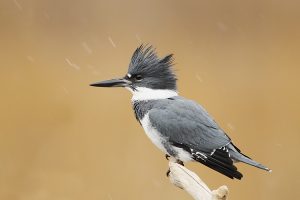CT DEEP Releases New Wildlife Action Plan with Support from UConn’s CAHNR
A group of researchers in the Department of Natural Resources and the Environment provided critical support for the Connecticut Department of Energy and Environmental Protection (DEEP)’s latest Wildlife Action Plan.
The UConn team was led by College of Agriculture, Health and Natural Resources (CAHNR) faculty Chadwick Rittenhouse, associate professor in residence and associate department head; Tracy Rittenhouse, associate professor; and Ph.D. student Kathryn Bischoff ‘22 (CAHNR).
This is the third Wildlife Action Plan that Connecticut, along with every other U.S. state, has released. The first report was released in 2005 following a federal requirement that states create a plan for wildlife conservation every 10 years. The plans identify animal species of greatest conservation need, their habitats, and the challenges they face. By identifying these priorities, states can better direct conservation, policy, and research. Funding for this planning effort was provided in part by State and Tribal Wildlife Grants, a program providing funding to states for biodiversity conservation.

A draft of the plan was released last week and is open for public comment until July 27.
During the public comment period, anyone can provide feedback on the list of species and habitats in need of conservation, the types of actions they would be most interested in taking in their community, or any other part of the plan.
“That public review is a very important part of wildlife management and conservation,” Tracy Rittenhouse says. “There’s a long, long list of potential actions that can be taken, and hopefully some of those actions resonate with different people who can see that list and say, ‘I can do that’ or ‘my group, we can do this’.”
DEEP and the UConn team worked closely with a diverse group of stakeholders in the state, including the Connecticut Audubon Society, the Nature Conservancy, land trusts, fish and game clubs, community groups like garden clubs, organizations based in urban areas, as well as municipal and town governments in developing the plan. The creation of this plan also included “Taxa teams” who contributed detailed knowledge about specific groups of animals – like mammals, amphibians, insects, or birds.
“From UConn’s perspective, I really do value the relationship with the state agency and their willingness to partner with people who have the expertise, who have the abilities, who have that desire to contribute to conservation in the state,” Chadwick Rittenhouse says.
Some of the concrete conservation actions in the plan include things like protecting land, vegetation management, habitat restoration efforts, increasing enforcement of existing protection laws, and continuing research and monitoring to learn more about high-priority species.
Compared to the version released in 2015, the 2025 plan reflects the development of a greater understanding of not only which species are in greatest need of conservation, but where in the state they live. This is one of the key contributions the UConn team made to the plan, identifying “Conservation Opportunity Areas.”
By identifying these areas, the plan can operate alongside local governments as they make decisions about planning and zoning, conservation groups that have their own maps, and highlight where education and engagement resources, like nature centers, could be added to better support conservation goals in these areas.
“It’s bringing a whole bunch of ecological and social data together to prioritize all those different actions and plan where on the landscape different partners can take action,” Bischoff says.
The UConn team is also developing a web-enabled plan with interactive resources for towns and community partners. This will include interactive maps and species profiles. It is scheduled to come out later this year.
“There are a lot of people involved, and there’s a lot of motivation and goodwill to do things well for conservation in the state,” Chadwick Rittenhouse says. “We’re really optimistic that good things will come for wildlife and fisheries in the state through this effort.”
This work relates to CAHNR’s Strategic Vision area focused on Fostering Sustainable Landscapes at the Urban-Rural Interface, and Advancing Adaptation and Resilience in a Changing Climate.
Follow UConn CAHNR on social media
Latest UConn Today
- Professor John Mathieu to Receive Academy of Management Organizational Behavior Lifetime Achievement AwardMathieu was nominated for the award by a team of former Ph.D. students, who contacted 30 professional acquaintances and asked them to submit recommendations to the 21,000-member Academy. While Mathieu said he is proud to see the impact of his work, he is equally excited to have mentored so many outstanding students.
- Leading with Resilience Personally and ProfessionallyMeet Resilient Administrative Program Coordinator Cassandra Keola of UConn School of Medicine’s Department of Medicine
- Increasing Contingency Management Incentives Will Help More Patients Recover from AddictionJAMA Psychiatry study recommends nationwide Contingency Management care guardrails with data-driven, evidence-based reward amounts to ensure effective and better care outcomes
- UConn School of Nursing Hosts Third Annual Early Introduction to the Nursing Profession Program‘Fostering a strong, diverse, and prepared future workforce.’ - MaryAnn Perez-Brescia, Ph.D., RN
- Despite Ad Bans, Young Children Frequently See Junk Food Promotions on YouTube and YouTube KidsNew study from UConn Rudd Center finds that children as young as age 3 are exposed to unhealthy food brand promotions when viewing videos on mobile devices
- Neag School of Education Hosts “Why Teach, Why Now” Contest for Early College Experience StudentsHigh school students submitted short essays or videos explaining why they want to become urban educators













